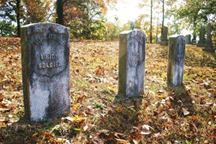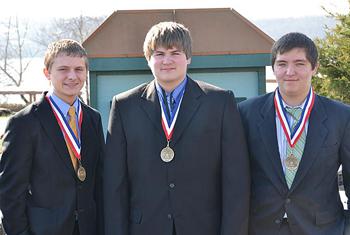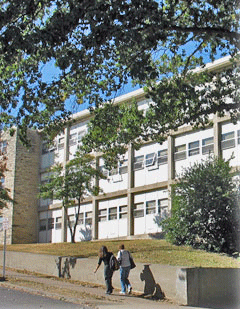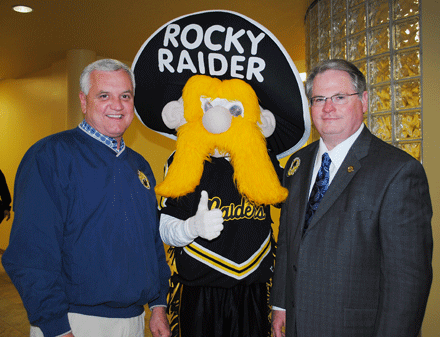
KRCU at Southeast Missouri State University announces plans to air a three-part series from “Backstory with the American History Guys” on the 150th anniversary of the firing on Fort Sumter that began America’s civil war. The series will air Sunday mornings at 9 a.m. beginning April 3.
April 3: The Road to Civil War
In hindsight, it’s easy to see the Civil War as a conflict just waiting to happen. But to Americans in the spring of 1861, disunion was anything but inevitable. In the days leading up to the firing on Fort Sumter, in fact, Virginia officials rejected secession by a two-to-one margin. Even among those who expected war, few imagined the scale of devastation that was just around the corner.
Taking as a starting point this uncertainty about what was to come, this episode focuses on the dramatic six months between Abraham Lincoln’s election in November 1860 and the outbreak of war in April 1861.
April 10: Why They Fought
One hundred 50 years ago, the Union went to war with the Confederacy. Ever since, Americans have been debating the causes of that war. Most historians today agree that it was fundamentally about slavery. And so what are we to make of the fact that most Southerners didn’t own any slaves, and most Northerners were not abolitionists?
Historian-hosts Brian Balogh, Peter Onuf, and Ed Ayers turn the question of the Civil War’s causes on its side, asking instead why Northerners and Southerners took up arms to fight one another. What causes, in other words, were they willing to die for?
April 17: The Civil War at 150: Questions Remain
As a companion to the two Civil War episodes, BackStory will offer a special listener Q&A edition of the program. For the duration of the hour, historian-hosts Peter Onuf (“18th Century Guy”), Ed Ayers (“19th Century Guy”), and Brian Balogh (20th Century Guy”) will draw on their trans-century expertise to answer questions from listeners on all aspects of the Civil War.
Photo Above: The 150th anniversary of the Firing on Fort Sumter that began the War Between The States will be observed in April. KRCU, the public radio station at Southeast Missouri State University, will feature a three-part series on the war in April. Southeast Missouri was central to the war effort in Missouri. Three unknown Union soldiers are buried at Sadler's Chapel Cemetery northwest of Dexter. (SMT file photo by Annabeth Miller)

A ShowMe Times News Report
A group of future leaders travelled to a statewide competition recently and was successful in competition.
Eleven students in the DECA program at Dexter High School participated in the DECA State Leadership Conference. The students qualified to attend the state conference through success at the district competition earlier this spring.
The Entrepreneurship Promotion team of Austin Seabaugh, Logan Crowley and Glen Parker placed fifth in the state in its competition. The purpose of the Entrepreneurship Promotion Project is for the team to show they can plan, organize, implement and then evaluate a campaign to show the opportunities available for an entrepreneur.
“This is the first time since I became DECA sponsor that a Dexter team has been recognized on the stage at state contest for winning a spot,” Tammy Crowley, DECA sponsor at DHS said.
Photo above:
The team of Austin Seabaugh, Logan Crowley, and Glen Parker, placed fifth in the state in Entrepreneurship Promotion at the DECA state meeting.

By Annabeth Miller, ShowMe Times Editor
CAPE GIRARDEAU, Mo. – March 26, 2011 - With the rising cost of food and gasoline and everyday expenses, colleges and universities are examining the cost of living making tough choices for the next academic year.
Like their peers across the nation, students at Southeast Missouri State University and their families will have to dig a bit deeper for living and eating on campus.
The Southeast Board of Regents met Friday and approved new room and board rates for the fiscal year that begins July 1. Under the approved plan, room and board rates will increase an average of 3.71 percent for next academic year.
Dr. Dennis Holt, vice president for enrollment management and student success, said average room rates will increase 3.37 percent, while average board rates will climb by 4.26 percent for fiscal 2012, bringing the average combined room and board rate increase to 3.71 percent for the 2011-2012 academic year.
New Dorm Rates
Based on the new rates, the cost of living in dorms will range for $3,750 in Dearmont to $5,750 for Vandiver, Henderson and New halls.

These figures reflect the cost to continue, including additional costs for maintenance and repair. Private room rates continue to be 1.5 times the rate of a double room, Holt said.
Dinner Time!
Holt says the average food plan change of 4.26 percent is consistent with the University/Chartwells dining contract and reflects actual and anticipated inflation in food prices for 2011-2012.

The flex dollars reflected in the board rates are cash stored electronically on students’ ID cards as part of their meal plan. They can be used at any campus dining location to buy additional meals, food items, snacks and beverages.
With the approved room and board rate increases, a student living in Towers South/East with a 15-meal plan will pay $6,360, up from $6,160 last year.
The Board also approved a three percent increase for non-traditional housing at Southeast. Southeast offers non-traditional housing at Washington Street Apartments, 19 units that vary in number of bedrooms, the size of rooms, and amenities.
Rates next academic year will range from $379.90 for a one-bedroom efficiency apartment at 505 Washington Street to $513.99 for a two-bedroom unit with a balcony at 401 Washington Street.

By Annabeth Miller,
ShowMe Times Editor
Things were all polished and new Thursday afternoon at the new Three Rivers College Center in Dexter - ready for the college president and Rocky Raider to show off the college's newest campus.
The college hosted an Open House for the community at the new facility on Market Street, and a steady stream of Dexter area residents visited and toured the center.
“This is one of Three Rivers’ most beautiful and advanced facilities,” said Dr. Devin Stephenson, President of the college. “This center is very important to us, and to the people of the Dexter area. I expect new, fresh ideas to come from this center.”
Stephenson and center coordinator Bill Hampton, assistant coordinator Ann Matthews and other college staff members offered tours of the college center, including the Green Diesel lab spaces, which include multiple cutaways of real trucks, truck engines, and more. The Student Ambassadors were on hand to greet visitors and even Rocky Raider, the college mascot was on hand to meet folks.
 The Dexter center is located at 515 West Market Street, off One Mile Road in Dexter. Portions of the former hat factory are still in use by the Dexter Chamber of Commerce and other businesses, with Three Rivers now occupying classrooms, offices, computer labs, lab spaces, and even a bookstore. Classes in the Dexter center began on January 18, 2011.
The Dexter center is located at 515 West Market Street, off One Mile Road in Dexter. Portions of the former hat factory are still in use by the Dexter Chamber of Commerce and other businesses, with Three Rivers now occupying classrooms, offices, computer labs, lab spaces, and even a bookstore. Classes in the Dexter center began on January 18, 2011.“We’re here to serve the students of Stoddard County and its surrounding areas,” said Hampton. “We invite prospective students, parents of students, and the community in general to come by and see the new facility. Ann and I will be on hand to answer any questions about course offerings, financial aid, and the center in general.”
Classes For Summer
Registration for summer classes at Three Rivers began this week with a full slate of classes being offered locally.Summer Classes will be offered in three sessions – June 6-28; July 5-28; and a full session from June 6 through July 28.
Among the classes to be offered this summer include general education courses such as Fundamentals of English, College Writing, American History Since 1877, Fundamentals of Math, Beginning and Intermediate Algebra, Public Speaking and more.
Other classes offered at the Dexter Center will include Art for the Elementary Teacher, History and Appreciation of Theater and Survey of Early Childhood Students also have the option of taking classes online. This summer, Three Rivers is offering over 70 online classes, which students can access from their home computer or any computer with an Internet connection.
Course offerings can be viewed online by going to trcc.edu and clicking on "Current Course Schedule." Students are encouraged to register for classes as soon as possible to ensure class availability. New Three Rivers students must register in person on campus, or at one of the college centers in Malden, Kennett, Sikeston, Portageville or Dexter. Returning students can register online at trcc.edu by using the myTRCC program.
Summer Registration continues through June 2 for in-person registration, and until June 5 for online registration. Regular registration for Fall 2011 is scheduled to begin on April 6. For questions about enrolling, registering, applying for financial aid or available programs, call the Three Rivers College Welcome Center at 573-840-9605 or toll-free at 1-877-879-8722.
Photos Above:
Top Photo: Three Rivers College President Dr. Devin Stephenson (left) and Dexter City Administrator Mark Stidham chat with the college's mascot, Rocky Raider, at the Open House.
Bottom Photo: Dexter Library Executive Director Pam Trammell (left) chats with Connie Hampton during a tour of the Three Rivers campus in Dexter. Hampton is the center coordinator at the college's facility in Malden.

The population center of the nation remains in Missouri, just a little south and west of it’s previous location.
Plato, Missouri, population 109, is the new geographic center of the population of the United States. The community is located in Texas County, and is near Success, Roby and Lynchburg.
U.S. Census Bureau Director Robert Groves congratulated the southeast Missouri town during a news conference Thursday.
"2010 is a special decade in our nation’s history," Groves said. "The center of the population has moved in a southerly direction in the most extreme way we've ever seen."
The Census Bureau calculates the center of population after each decennial census. It determines the center based on where an "imaginary, flat, weightless and rigid map of the United States would balance perfectly" if all 308,745,538 residents weighed the same amounts.
The center has been located in Missouri since the 1980 census.
After analyzing the data from the 2010 Census, the new population center is 2.7 miles northeast of Plato in Texas County, Missouri.
The announcement was made today at the National Press Club in Washington, DC, by U.S. Census Director Robert Groves.
 “It’s a unique distinction for our congressional district to contain the population center of the entire country, and I think it is in many ways fitting that the center falls right in the middle of the Heartland,” U.S. Rep. Jo Ann Emerson said.
“It’s a unique distinction for our congressional district to contain the population center of the entire country, and I think it is in many ways fitting that the center falls right in the middle of the Heartland,” U.S. Rep. Jo Ann Emerson said.
“Our congressional district is a patriotic place, we are home to strong communities, we place a high value on public service, and, to me, we represent the very heart and soul of our nation. No matter where you live in America, you would find a warm welcome if you came to Plato and sat down for coffee in the morning.”
Emerson also noted that the southward shift of the population center reflects the growth of population in southern U.S. states.
“It’s just a short drive from Edgar Springs to Plato in Missouri, but you think about the larger demographic shift in our country. It kind of boggles your mind to think about the movement of millions of people around our country and how we can simply represent that with the mean population center statistic. This is a great teaching tool for our local schools as well as for students around the nation who are learning more about the makeup of our country’s population and how the trends affect our national identity,” she said.
Ever since Chestertown, Md., was determined to be the center of population after the first census was conducted in 1790, the center of population has told the story of America, illustrating how we've grown as a nation. It follows a trail across the country — across Maryland, Virginia, West Virginia, Ohio, Kentucky, Indiana and Missouri — that reflects our history of settling the frontier, manifest destiny, waves of immigration and regional migration.
The Census Bureau reports it will install a commemorative “geodetic control mark” at a site near the official coordinates during a dedication ceremony in April 2011. This survey disc will be used by satellites and land surveyors to conduct scientific surveys to generate precise position data that serve as the foundation for accurate mapping and charting in America.

